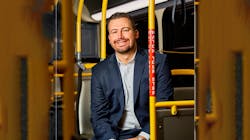One word to describe yourself: Passionate
Alma Mater: University of Virginia, San Jose State University (Mineta Transportation Institute)
Fast fact about yourself: I’m a proud father of two sons, Ethan and Chase, who love riding buses and trains almost as much as their dad.
What’s your best experience on transit and what made it memorable?: Riding all seven bus providers in Northern Virginia in a single day as a team building exercise last year. It was inspiring to see all the things we are doing as a region to meet the mobility needs of our residents and provided our team with a few good ideas for how to make DASH even better than it is today.
As director of planning and marketing at Alexandria Transit Company (DASH), Martin Barna, MSTM, has revolutionized transit in Alexandria, Va., and helped the agency make groundbreaking strides in providing more useful fixed-route bus service for the Alexandria community. Since joining DASH in 2017, Barna has led the agency’s planning team through unprecedented challenges and several ambitious projects, including the most significant rail shutdown in Metrorail history in 2019, the COVID-19 pandemic, the introduction of a permanent systemwide fare free program and the launch of a completely redesigned network in 2021. Colleagues note Barna’s efforts have resulted in the most accessible, equitable, frequent and convenient public bus transit service ever achieved in Alexandria.
In partnership with the city of Alexandria, Barna led DASH’s efforts on the Alexandria Transit Vision (ATV) Plan, which outlined two new networks:
- A preliminary, transitional network to debut by 2022
- A final 2030 network to be implemented gradually over the next decade
Barna subsequently led the implementation process of the preliminary 2022 ATV network, known as the fare-free “New DASH Network,” with a focus on the community, current and potential DASH ridership and a spirit of collaboration with internal and external stakeholders.
The service changes associated with the New DASH Network represented the most substantial single-day service change in the agency’s history. The agency successfully launched a completely redesigned network that provides the most frequent, accessible and convenient public bus transit service ever offered in Alexandria while simultaneously ceasing the collection of passenger fares. Barna hosted and led the collaboration that made this project possible, including planning task force meetings, information sessions and meetings with local civic organizations that formed the backbone of the planned network changes. As a direct result of Barna’s New DASH Network and Fare-Free initiative, DASH’s ridership in 2023 has not only surpassed pre-pandemic levels, but has also been the highest in all of DASH’s 40-year history.
DASH riders and the city of Alexandria now enjoy fixed-route, public bus transit service that not only serves the current needs of the city’s diverse community, but will grow with it. With the introduction of frequent, all-day service across the city and the complete elimination of passenger fare collection, Barna and DASH have removed significant barriers to transit access and equity in the community.
Prior to working with DASH, Barna began his career in public transit in Northern California at the Santa Clara Valley Transportation Authority (VTA), where he had worked under the leadership team of now-current Federal Transit Administration Administrator Nuria Fernandez in service planning and scheduling leadership roles. His work at VTA included leading the bus and light-rail service and operations planning for Super Bowl 50 at Levi’s Stadium, which brought more than 70,000 visitors to the area, the Next Network bus network redesign project and a mictrotransit pilot project called VTA Flex. Immediately prior to joining DASH, Barna was responsible for the service delivery and quality assurance of Fairfax Connector, a system of more than 300 buses in Fairfax County, Va.
Is there a specific experience that led you to where you are today?
Growing up outside Washington, D.C., I would often ride the Metrorail into town to see the museums, watch fireworks on the Fourth of July, and go to ball games at RFK Stadium. I remember marveling at the sense of a community aboard crowded Metrorail trains and the smooth efficiency with which the system operated. It was these trips that sparked my interest in cities at an early age and led me to my studies in Urban & Environmental Planning and my eventual career in public transportation.
What do you enjoy most about your job?
Pretty much everything! As a transit planner at a smaller agency, we get to spend each day with a new challenge and a different set of puzzle pieces to try to fit together. If we do a good enough job fitting those pieces together, we can make our service run a little bit better today than it ran the day before, and each incremental improvement has the potential to improve the quality of life a little (or a lot!) for our riders and the community as a whole.
What’s the most challenging part of your job?
One of the toughest parts of working in public transit is securing consistent funding for the agency’s annual operations budget. DASH is fortunate to have the steadfast support of city leadership but still faces some of the same larger long-term fiscal challenges as most other agencies across the country. With constrained budgets, rising costs and competing priorities like service expansion, fare relief programs and zero-emission fleets, we often face difficult decisions and are unable to do all that is needed to provide the transit service our community needs and deserves.
Accomplishment you’re most proud of and why?
I’m most proud of the work that my team and I did for the ATV Plan and the resulting implementation of the New DASH Network in 2021, which created a much more useful and productive bus network for the city of Alexandria.
Beginning in 2019, we embarked on a three-year project to redesign our entire bus network to better reflect community priorities and to provide more useful bus service in places where more people could use it. I was able to lead the planning for implementation of the New DASH Network, which occurred overnight on Sept. 5, 2021, and required careful coordination with the entire DASH organization and dozens of internal and external stakeholders.
The new, fare-free bus system immediately doubled the number of city residents within walking distance of a bus route that runs every 15 minutes or better, all-day, seven days per week. In the two years since this implementation, DASH has seen unprecedented ridership growth and the 4.5 million boardings recorded in Fiscal Year 2023 are the highest of any year in our agency’s 40-year history. Leading this multiyear planning and implementation process and seeing the immediate impact of that work has been the most rewarding experience of my career.
Best advice/tip/best practice to share from your area of expertise?
As a transit planner, I’ve learned that service frequency is the biggest key in determining the usefulness of the service for most riders and bringing routes up to a more useful frequency should be a top priority. The multiplier effect of frequency on ridership has been proven time and again and aligns with my direct experience with two major network redesign projects in the last decade. Bus routes that can be improved to the threshold of running every 15 minutes or better, all day, seven days per week are likely to see disproportionate increases in ridership, perceived service reliability and overall customer satisfaction.
About the Author
Brandon Lewis
Associate Editor
Brandon Lewis is a recent graduate of Kent State University with a bachelor’s degree in journalism. Lewis is a former freelance editorial assistant at Vehicle Service Pros in Endeavor Business Media’s Vehicle Repair Group. Lewis brings his knowledge of web managing, copyediting and SEO practices to Mass Transit Magazine as an associate editor. He is also a co-host of the Infrastructure Technology Podcast.

